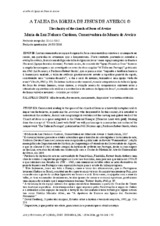Mostrar el registro sencillo del ítem
A talha da Igreja de Jesus de Aveiro
| dc.contributor.author | Nolasco Cardoso, Maria da Luz | |
| dc.date.accessioned | 2018-10-11T07:09:22Z | |
| dc.date.available | 2018-10-11T07:09:22Z | |
| dc.date.issued | 2018 | |
| dc.identifier.issn | 2530-0814 | |
| dc.identifier.uri | http://hdl.handle.net/10396/17236 | |
| dc.description.abstract | Leitura comentada ao espaço da igreja de Jesus como metáfora celeste e o seu impacto no crente, em particular os aveirenses que a frequentavam. Neste contexto, pretende-se entender a evolução estética, formal e morfológica da talha da Igreja de Jesus2 como espaço integrado no Barroco Nacional [Igrejas forradas de ouro]. Partindo assim, do conceito de “Igreja Forrada a Ouro” faremos a singela homenagem a um investigador e autor da obra singular “A Talha em Portugal”, publicada em 1962 (há 54 anos), o Professor Robert Smith3, que se passa a citar: “segundo a tendência barroca à harmoniosa unidade, a talha do retábulo grandiosamente invade a superfície parietal da capela, constituindo uma “caverna dourada”, e daí o resto do interior, tornando-o uma igreja <toda de ouro>4 (Smith, 1962 p: 89). Da leitura histórica e documental, visual e interpretativa da talha da Igreja de Jesus de Aveiro faremos, como síntese, a avalição acerca do compromisso existente entre a sobriedade arquitetônica do edifício e a exuberância do interior da Igreja de Jesus5, materializando-se de forma visível o invisível – invisibilia per visibilia. | es_ES |
| dc.description.abstract | Commented reading to the space of the church of Jesus as a heavenly metaphor and its impact on the believer, in particular the Aveirenses who frequented it. In this context, it is intended to understand the aesthetic, formal and morphological evolution of the carving and gilded work of the Church of Jesus as a space integrated in the National Baroque [Churches lined with gold]. Starting from the concept of "Church Lined with Gold" we will pay homage to a researcher and author of the unique work "The Talha in Portugal", published in 1962 (54 years ago), Professor Robert Smith, which goes on to quote: Baroque tendency to harmonious unity, the carving of the altarpiece grandly invades the parietal surface of the chapel, constituting a "golden cave", and hence the rest of the interior, making it a whole church of gold8. Thus, based on the historical and documentary, visual and interpretative reading of the carving of the Church of Jesus of Aveiro, we will evaluate the compromise, as syntheses, between the architectural sobriety of the building and the exuberance of the interior of the Church of Jesus, materializing in a visible way the Invisible - invisibilia per visibilia. | es_ES |
| dc.format.mimetype | application/pdf | es_ES |
| dc.language.iso | por | es_ES |
| dc.publisher | Asociación para la investigación de la Historia del Arte y del Patrimonio Cultural “Hurtado Izquierdo” | es_ES |
| dc.rights | https://creativecommons.org/licenses/by-nc-nd/4.0/ | es_ES |
| dc.source | Arte y Patrimonio 3, 93-114 (2018) | es_ES |
| dc.subject | Talha dourada | es_ES |
| dc.subject | Documento | es_ES |
| dc.subject | Monumento | es_ES |
| dc.subject | Dispositivo | es_ES |
| dc.subject | Estrutura retabular | es_ES |
| dc.subject | Gilded carving | es_ES |
| dc.subject | Document | es_ES |
| dc.subject | Monument | es_ES |
| dc.subject | Device | es_ES |
| dc.subject | Retabular structures | es_ES |
| dc.title | A talha da Igreja de Jesus de Aveiro | es_ES |
| dc.title.alternative | The charity of the church of Jesus of Aveiro | es_ES |
| dc.type | info:eu-repo/semantics/article | es_ES |
| dc.rights.accessRights | info:eu-repo/semantics/openAccess | es_ES |

